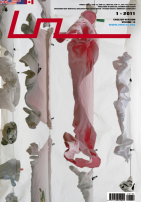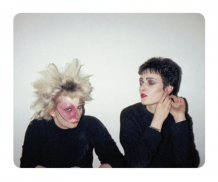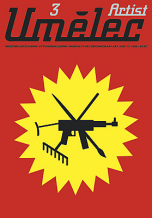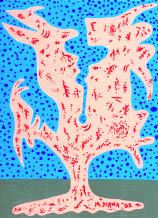| Revista Umělec 2011/1 >> What’s to be seen from the top of the Dark Mountain | Lista de todas las ediciones | ||||||||||||
|
|||||||||||||
What’s to be seen from the top of the Dark MountainRevista Umělec 2011/101.01.2011 Tristan Russel | solutions | en cs de |
|||||||||||||
|
Interview with Dougald Hine
As with so many things the future is an uncertain place. Do we make plans only to see them wither on the vine or just let the tide of history wash over us? With so many things to think about and so many metaphors for us to use it is a wonder we get anything done at all. The future then; it might be seen as an imaginative space that in this fast paced modern world is something of a luxury to indulge in. Are we not already living in the future? And correct me if I’m wrong but I am fairly sure I was told about history ending at the end of the 1980’s. That imaginative space however, is a necessarily important part of our biological make up, the ability to project our thoughts forward and to plan for abstracted concepts in some small way is what makes us human. Without the future we risk standing still. To ask these types of questions is natural enough, but to get sensible answers is a little more unusual. I first met Dougald Hine, co-founder of the Dark Mountain Project with Paul Kingsnorth, at the top of the stairs to the Náměstí Republiky metro station in Prague. Dougald, who has spent time at the BBC and has set up a number of forward thinking social projects, is intent on providing people with the space in which to thrash out the concerns and concepts that may result from the decline of Western Civilisation; I should clarify this by saying that his is not an apocalyptic vision, more a pragmatic stance on the assumption that, “this must end.” The interview that follows is the result of that encounter, taking in ideas from the rise of “bookish” reading through to the prevalence of Jugaard technology, we hope it shows that the End of the World is not the end of the world. ¬ What is the Dark Mountain Project? The Dark Mountain Project started as a conversation in the pub between me and Paul Kingsnorth. We had met through a shared frustration with the current cultural situation, having arrived at similar conclusions from different directions. Paul had been deputy editor at the Ecologist, but had become increasingly frustrated with the mainstream discourse of environmentalism, the way “sustainability” had narrowed to the attempt to sustain our current way of living. The ecological movement had injected its concerns into mainstream culture, but in the process it had lost the critical thinking that was once associated with it. Meanwhile, as writers, we both felt that the version of English literature fed to us through the Review sections of the broadsheets had become irrelevant to the current situation of the world. The novels it celebrated lacked a certain engagement; although this is hard to say properly. It’s not that contemporary writers are not producing ‘engaged writing’, but that, in most cases, the assumptions on which their writing is based will very likely seem irrelevant or offensive in the near future. ¬ Why do you feel that this is important now? I think a lot of people have been waiting for the permission to speak openly about their doubts concerning the narratives of environmentalism, sustainability and the apocalyptic shadow that seems to haunt modern culture. You see, I find it quite ironic that the Dark Mountain Project has been described as predicting – or even hoping for – some kind of apocalypse. In the closing lines of the manifesto, we say “The end of the world as we know it is not the end of the world, full stop.” Mainstream culture seems to narrow the future to two possibilities: either an extension of life as we know it, or the unliveable nightmare of Cormac McCarthy’s The Road. The gap between those – the future which is unlike the present, in which many things have been lost, but life continues to be liveable – this is not talked about as a possibility, yet it is within this gap that we are most likely to find ourselves, and where imagination is most needed. And I am not proposing some Science-Fiction fantasy, but that imagination can help us find the attitudes by which we can navigate the disruption which will accompany the end of the world as we used to know it. ¬ As with any collaboration there will be certain differences, what has been (if any, of course) the main obstacle, be that intellectual or practical, you and Paul have needed to overcome? I have been very lucky in the partnerships which have accompanied my work over the last few years, because I have come across people who are asking similar questions, but approaching them with differing experiences, styles or tastes. In terms of my relationship with Paul, I think I approach things more obliquely where he tends to tackle things head on – and for a working partnership, that combination is very useful. Also, having two distinct voices and styles has meant that Dark Mountain does not project a simple didactic vision – and, whereas this has disappointed some people who would prefer a prescriptive structure or a defined political aim, for us it has meant we can open a space for discussion rather than set a line of opposition. ¬ John Berger is listed on the site, what do you attribute to him that makes him a relevant predecessor? One of the most important aspects for me is the transformation in his work as a result of his encounter with, and decision to live alongside, French peasants in the Alps; it sets up an intricate dialogue between the Marxist humanism, which is already subtle and powerful in his early work, and this different way of perceiving and living in the world. In issue one of Dark Mountain, I wrote about the way in which Berger tests what can be believed against what can be endured. This leads to a fierce rejection of the nihilism of our consumer culture, because such nihilism can only be sustained within this bubble of comfort which acts to anaesthetise us against the realities of human existence. Against that, Berger describes the ability of the peasants, with whom he lives, to wrest meaning from chaos. They are possessed of an endurance which he says, and I believe him, is capable of outlasting our comfortable view of the world. And here you find, in the end, the aesthetic and the political in his writing converge on the priority of seeing. It has become the defining activity of the rich to put up walls, he writes – both physically, as in Palestine, but also walls of the mind, protection from reality, anaesthesia – so that it may be only the poor who can afford to see the world as it is. ¬ Which other artists/writers etc. do you feel have inspired your vision of the Dark Mountain Project? Well, I am very conscious of not wishing to shanghai my heroes and put their work into service. With that warning, there are a couple of writers and thinkers whose work should inspire us to redraw the maps, as Geoff Dyer puts it. Ivan Illich would certainly be one and also Alan Garner, who is really one of the great writers in English today. There is a depth and a force in his later work which draws us out of the comfortable certainties of the time we happen to find ourselves in, onto the ledge of history. There’s a larger point here: we tend to treat the past as a poorer version of the present, a first draft, a discarded prototype. To take two seemingly opposite examples; Christian Fundamentalists and Richard Dawkins-style atheists both suffer from an acute version of this habit, because they each insist on reading Genesis as an early physics and biology textbook. With Garner, you are faced with the radical strangeness of the past, how different the world looks from other times and places, and this is another route beyond the bubble of the world as we know it. Another writer we could talk about is William Golding, a writer who is incapable of ignoring the made-ness of things, the past contained within the present, the process represented in the pattern. Perhaps we can draw a line between this way of seeing, in which things are always situated within time, and another kind of writer who sees only the present relations of his or her subject. Golding puts his finger on this, when he tells the story of how he came to write ‘The Spire’. He was standing on a bridge in the middle of Salisbury, thinking about how Trollope had written so much about this city and its cathedral, and wondering how it was possible that he had done so without even mentioning the spire. It is hardly mentioned in the Barchester chronicles. So Golding says, Trollope was not very concerned with what things had been or what they would become, and therefore with what things mean. You could make a Marxist reading of this, in which Trollope embodies a 19th century bourgeois attitude to reality, in which a veil is drawn between the circumstances of production and the experience of the circumstances of consumption, a way of living which can only be sustained if we do not think too hard and avoid thinking about how the things which furnish it come to be made – and of course, it soon becomes clear that such an attitude is hardly remote from our own experience. But there are different paths by which writers arrive at this other attitude, which I am associating with Golding, and with the kind of writing which Dark Mountain seeks and celebrates. For Berger the route is certainly via Marx, but for Garner it comes out of an older culture of craftsmanship which is part of his own and his family’s history. In each case, it leads to a deep attention to the past and future of things, the stories and the care embedded in them. ¬ As well as writing there are a number of other art forms represented through the Project do you feel that there is any particular one that is most able to affect change in our overall conciousness? As I see it the Project is less about affecting change, more about observing the reality as it unfolds and learning ways to respond and interact with the change which is already all around us. There was an interview between Bruce Sterling and the designers Dunne & Raby – they are talking about their students, who I guess are in their early twenties, and how the particular roles we used to identify as writer, designer or whatever have become so fluid that they no longer take them seriously. It has to be explained to them how sharp the boundaries were until very recently. What I see here is the rise of improvisation and this is something which I believe can offer clues as to how we make a good job of living through difficult times. A lot of these young designers are getting excited about the jugaad technology of Indian villages, this ramshackle, improvised stringing together of whatever materials are to hand which looks to a western eye like it should not work, except it does. Here I see another historical fault-line between two different approaches to reality, between improvisation and orchestration. We think of improvisation as this difficult, specialist skill, but that is an effect of the Industrial Revolution. I want to say that this is a very particular historical perspective, one which owes a great deal to the Industrial Revolution and the age of orchestration which accompanied it. There is something in common between the rise of the factory and the rise of the large orchestra, the mass coordination of bodies, all under the will of a single director. This is also the moment, historically, in which the convention of public silence in the street and in the theatre emerges for the first time. And you could look to the change in the customs of buying and selling, from the marketplace, in which prices emerge from sociable interactions, to the department store window, in front of which you can only stand with your mouth open. Through all of this, you have a new ability to harness effort and desire through new technologies and systems, a world in which orchestration has become the winning strategy. This may never have been good for the heart and soul, but it is now increasingly questionable whether it has reached its limits, even on the levels at which it delivered the goods. Our systems become more complex, the tight coupling of orchestration adds to their precariousness, the future becomes increasingly unpredictable – but the skills and strategies of improvisation are about operating without knowing what’s coming next, in circumstances where having a plan doesn’t help, and I think there are possibilities here for navigating the times of great uncertainty which are already all around us. ¬ To come back to Ivan Illich, can you say more about the relationship of his work to the Dark Mountain Project? Something I find helpful in Illich is the historical depth which he brings to his arguments. For example, in his writings from the early 1990s, he talks about “the death of bookish reading,” a phrase he takes from George Steiner, telling the story of the transformation of the university from a book-centred institution to an information-centred institution. What is powerful in the way he writes about this, and what saves it from being reactionary, is his ability to hold in mind the beginning as well as the end of the age of the bookish university. He has what you might call a long stride. So he can mourn the good things which are being lost and offer a reasoned critique of the new age of information systems, while also recognising in this historical moment the possibility of reconnecting to what was lost or marginalised in that earlier transition from the age of monastic reading to the scholastic reading culture which formed the university. Monastic centres of learning were oriented around a voiced, embodied, communal culture of reading. Then within a generation or two you have a whole new apparatus of random access technology, called the alphabetical index, and a host of other new technologies – and this is hundreds of years before the printing press, but for Illich it is perhaps a more significant shift, because it leads to a privatisation of reading and a new tendency to see knowledge as a commodity to be acquired, rather than a process which transforms the knower. So what Illich offers is this complex attitude to history, which is neither a cold detachment, nor a romantic elevation of the past or the future. ¬ On a number of occasions you cite humanity’s disengagement with nature and the need to re-engage; a) could it not be said that it was our initial fascination with the natural world at the birth of our modern sciences that has led us down this course and b) if this is so how do you propose to subvert the same from happening? Ran Prieur would be better on this – he writes fascinating essays and blog posts about the cycles of the rise and fall of civilisations, stretching the imagination into the past and the future. The Dark Mountain question is humbler, I think. We are asking how we live now and in the near future, how we get through as best we can, recognising that many questions will be left for future generations to answer. But to look at it, the paradox of natural philosophy, as the founders of the scientific revolution would have described their work, is that the re-awakening of fascination in the world was entangled with an alienation from it. You can see this in the roots of anthropology and the study of folklore during the 18th and 19th centuries: a gap had opened between high and low culture, of a kind which had not existed a few generations earlier, and this gap allowed the elite of the time to rediscover ‘lower’ forms of culture as something strange and fascinating. Now, the emergence of that gap happens at the same point as the rise of natural philosophy and a radical change in the attitude to what can be known. For Hamlet, there were still “more things in heaven and earth... than are dreamt of in our philosophy.” Shakespeare’s world is characterised by the possibility of cohabitation with the unknown. Over the 17th century, however, there was a remarkable extension of what could be known. In one sense this is obvious, because there were huge advances in a particular kind of knowledge, which we have come to call science. But there was also a parallel and non-scientific redefinition of reality – an unprecedented and unfounded assertion that everything which is real must be capable of being known by humans. The ‘unknown’ is now a territory to be conquered. This is a huge break from an older and, in many ways, saner attitude in which we see “through a glass darkly,” our awareness of reality a murky reflection of something fuller and always partially mysterious. This childlike, humbler, wonder-filled attitude is displaced by the new direct vision – literally in the exciting breakthroughs in optics that characterised the new science – and also in the stories of humanity’s coming of age which would develop into the self-image of the Enlightenment. In all this excitement, we arrived at the idea that it would be possible to create heaven on earth, and while this freed us from certain dogmas, the new world it inaugurated was based not on scientific knowledge alone, but on a new set of stories. What is dangerous is when the entanglement of these stories with science leads to the denial that they are stories and by no means the only stories which can be told. Again, there is the paradox that in ridding ourselves of certain unhealthy dogmas, we also lost a kind of epistemological humility which is implicit in earlier understandings of reality – and so, even as our scientific knowledge allowed us to exploit nature more effectively, the beliefs which accompanied it more often than not served as obstacles to a deeper understanding and relationship with the world in which we find ourselves. ¬ The ideas and processes of thought that Dark Mountain is wishing to instil may take decades to take root, by what mechanism do you see this happening, and do we have the luxury of time to do it? The difficulty in this question is that we do not see this as a campaign that must be won or an attempt at ‘behaviour change’. Dark Mountain starts with an invitation to whoever wants to join us in a conversation and in a search for ways of writing and ways of seeing which can meet the gaze of the unknown world into which we are headed. What is inspiring is that there has been a large group of people who have responded to that invitation with a sense of relief, for whom it has unlocked things, and who come back to us and surprise us with their own ideas and feelings. ¬ So do you feel that the Project must eventually grow beyond your control as an autonomous entity? I think it already has. Conversations are naturally out of control, anyway, something we improvise as we go along, which brings us back to this sense of improvisation as something deep in what it means to be human. The Manifesto was a way of starting this conversation, but what happens after that Paul and I can have no hope of controlling. Already there are Dark Mountain inspired events happening in all kinds of places. ¬ So this is the Desert Island Discs question (a long running BBC Radio 4 program for our readers outside the UK): if we are to suffer a steady economic decline and the associated technological stall, what would you hope to be able to take with you? [thinks] So, the John Gray answer would be something like anaesthetic dentistry. The Vinay Gupta answer would be the Internet, because of its capacity for the dissemination of information. On a personal level, though, it would be my friendships and personal connections; those you trust and those who trust you are the people who will see you through hard times. ¬ Now a lot of what we have been talking about is based on the premise that we will suffer the demise of the current economic and social structures we are used to, yet you do not seem overly distraught by this, why? The human race is good at muddling through. We’ve been here a long time and there are some things in us that are innate, including an ability to find meaning in the middle of hardship. ¬ Can you turn that around? This is not to romanticise hardship. We live in a dance between the hard material elements of reality and softer social elements. We find meaning by reworking the social and the cultural, which then allows a grip on the harder material reality.
01.01.2011
Artículos recomendados
|
|||||||||||||
|
04.02.2020 10:17
Letošní 50. ročník Art Basel přilákal celkem 93 000 návštěvníků a sběratelů z 80 zemí světa. 290 prémiových galerií představilo umělecká díla od počátku 20. století až po současnost. Hlavní sektor přehlídky, tradičně v prvním patře výstavního prostoru, představil 232 předních galerií z celého světa nabízející umění nejvyšší kvality. Veletrh ukázal vzestupný trend prodeje prostřednictvím galerií jak soukromým sbírkám, tak i institucím. Kromě hlavního veletrhu stály za návštěvu i ty přidružené: Volta, Liste a Photo Basel, k tomu doprovodné programy a výstavy v místních institucích, které kvalitou daleko přesahují hranice města tj. Kunsthalle Basel, Kunstmuseum, Tinguely muzeum nebo Fondation Beyeler.
|






























 We Are Rising National Gallery For You! Go to Kyjov by Krásná Lípa no.37.
We Are Rising National Gallery For You! Go to Kyjov by Krásná Lípa no.37.
Comentarios
Actualmente no hay comentariosAgregar nuevo comentario